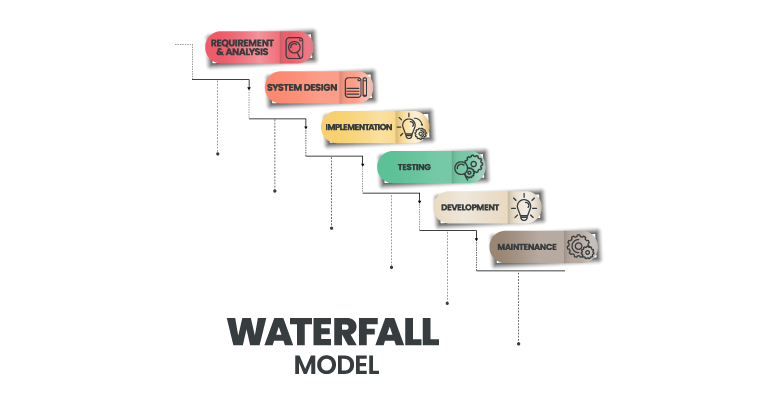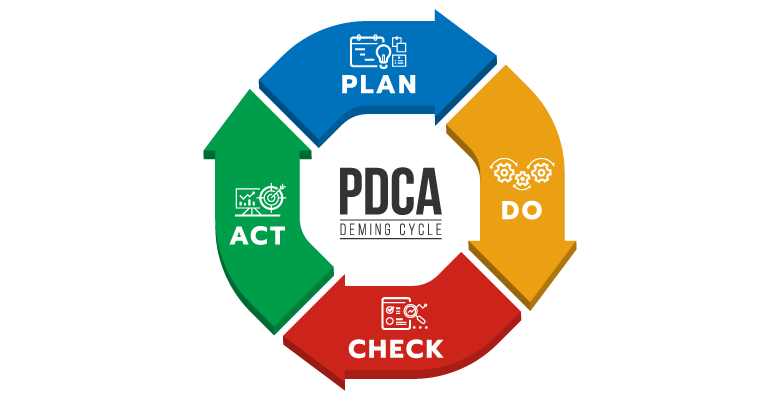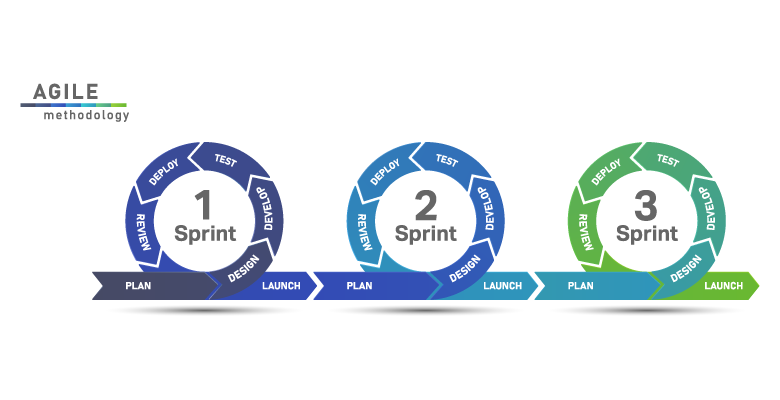Welcome to the world of terminology and beliefs
Once you have clarified why your company should get into digital sales and which technical aspects have to be fulfilled for this, the next question arises: How should your e-commerce project be implemented? In other words: What is the procedure and method used to bring your online shop to life?
To clarify the question, you have three approaches to choose from:
1) Classic project management
2) Agile development
3) Hybrid approach
Each approach offers unique features and certain advantages and disadvantages. We will show you these briefly and clearly here.
Classic project management aka waterfall model
A typical project has a beginning and an end, with numerous milestones in between. Distribute the milestones across different phases, such as conception, design, programming and testing. Each phase is not started until the previous one is completed.
To present your project plan, place the individual sections on a timeline and arrange them slightly offset one below the other. This creates an image that looks like the cascades of a waterfall. That is why this procedure is called the waterfall model.


The waterfall model has been used in project management for decades. It has also proven itself in software development because it fits the typical release cycles of the industry. If the plan was to sell the new version of product X on day Y, the project manager could “break down” the available time and allocate tasks accordingly.
Flexible software development aka Agile
Nowadays, software development, which also includes the implementation of an online shop, is clocked much faster. Projects are no longer planned, implemented and published over years or months. Instead, it is important to present the first results within a few days or weeks. After that, new updates will follow regularly at short intervals.
A digital product is actually never finished. To put it bluntly, it is in permanent beta mode. An example: Did you know that Amazon releases a new release of its platform several times a day? This is difficult to plan and implement with the waterfall model. To enable high output, you need a new approach called agility.
Agile corporate cultures, frameworks and methods are based on the PDCA cycle. The acronym stands for:
- Plan
- Do
- Check
- Act
This procedure was invented by William Edwards Deming, which is why it is also called the Deming Cycle.


If you and your team follow the PDCA cycle, this means: you design a new feature, implement it, publish it and get user feedback. Based on the feedback and your open ideas, the next cycle will be planned and implemented.
Repeat this cycle continuously and at short intervals. It is therefore important that only a few features are in focus per cycle. Various types of implementation have been established for the application of the Deming Cycle in recent years. These include Kanban, DevOps and Scrum.
How does Kanban work?
Kanban makes it easier for you to work in an agile team. You are certainly familiar with the visual implementation: there is a large board with numerous notes stuck to it.


Each piece of paper represents a task, which you first stick in the left-hand column. This is labeled “To Do”. The columns that follow are usually named "In Progress," "Testing," and "Done."
Each team member takes a piece of paper, sticks it in the “In Progress” column and works on the task. Once the task has been completed, the note moves to the "Testing" area. If the test is positive, the post-it goes in the “Done” column. Of course, you can also map the whole process digitally with tools like Asana and Trello.
Kanban has a few peculiarities. On the one hand, it works according to the pull principle, since each team member can freely choose a suitable task and then assume responsibility for it. On the other hand, only a few tasks may be processed per cycle. Otherwise, the fast pace of agility is not manageable.
What does DevOps mean?
SIn software development there is actually a clear separation between development and operation. While designers and programmers usually want to implement as many features as possible, administrators are interested in a stable, secure infrastructure without changes. As a result, a dispute arises between the parties.
You resolve this conflict with the DevOps approach, because you let development and operations merge into DevOps. To do this, use the CAMS model. CAMS means:
- Culture
- Automation
- Measurement
- Sharing
The basis for DevOps is the new culture (= culture), in which you convert the separation between development and operation into cooperation. For close and fast cooperation you need tools to automate processes (= automation). This is achieved using programs such as GitHub and Jenkins, which enable continuous integration and continuous delivery.
As always in agile development, checking and analyzing the results (= measurement) is important, as is the exchange between those involved (= sharing).
How does Scrum work?
Speaking of sprints: These short intervals are an elementary part of Scrum. This is probably the most popular framework in agile software development. In order to use it, you must first create new positions and structures.
A product owner is assigned to the product manager and project manager, with one person wearing all three “hats” in small companies or teams. The product owner defines, among other things, the characteristics of your online shop and is responsible for its economic success.
The Scrum Master ensures that the agile process works. He clears obstacles out of the way, for example by promoting communication in the team and mentally supporting individuals. The development team implements the requirements that are pending in a development cycle - the sprint.
After development, testing and publication comes the review and planning of the next sprint.


What are the advantages and disadvantages of agile online shop development?
If you have fast release cycles, there are several benefits. In this way you can see the first results in a short time and test them on your target groups. With the MVP, the minimum viable product, you can see whether your concept will be accepted or not. And you get the opportunity to further develop your online shop based on customer feedback. As the saying goes: "The worm must taste good to the fish and not to the angler!"
However, agile development has a major disadvantage: Many things cannot be planned exactly. If you really follow the wishes of your users or customers, you don't know what your online shop will look like in a year and what the implementation will cost. Of course, this approach is a thorn in the side of all budget planners!
This is where the waterfall model plays its trump cards: With this project management method, you plan in detail what the individual milestones will look like and what they will cost. This gives controlling and the entire development team more predictability.
Can classic project management and agility be merged?
Yes. With a hybrid approach, you have to try to reconcile the advantages of both worlds. For example, you can divide the project - the development of your online shop - into several milestones in the classic way and make rough feature specifications for this. These can be provided with an approximate price. However, the implementation within the milestones is not rigid, but according to Scrum.
In addition to this approach, there are countless other forms of hybrid project management. In the end, you need to find a way that works best for your team and all stakeholders.
It is always important: Always be flexible! Even if you opt for a purely agile online shop development based on Scrum, that does not necessarily mean that you are nailed down to it. Adapt the framework to your circumstances. In the end, it's about being able to advance your project as quickly as possible, with high quality and within budget.








